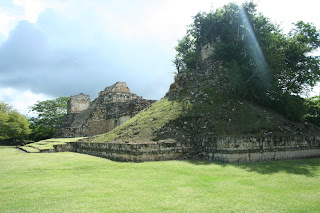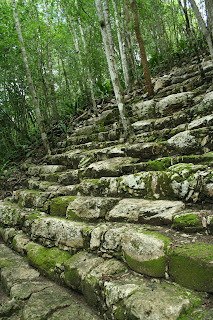Took the first bus out of town. These ruins really blew my mind. A lot has been written about these ruins, but a lot of important work has been done here in the past few year. The architecture is supposed to be 'unique' with a mix of influences. I really am not sure who first said this. The architecture spans nearly 2000 years, so there is a LOT of different styles to see. The earliest styles are Late Preclassic. There are very few late preclassic examples in the Yucatan, so this was great. Just uncovered are two new stucco masks. They are amost entirely smashed, but there are still a few parts left still with paint. The late preclassic style is strongly southern, with 'apron moldings' (see photo below) and super interesting was a type of unusual molding from south western Campeche, known as the Candelaria region. I have not studied this region, but it is clear now it is likley very important to the development of the northern architecture and possibly masonry.
Most architecture seems to be early classic. The style and masonry of this is very much like the late preclassic. I will not talk too much about it, but it is different from any other early classic masonry I have seen. The most remarkable thing about it is a preferance for the builders to stack the stones on end, so they are used as much like tiles as possible. Once on the wall as a tile, they also liked to make the longest side vertial. This is entirely unlike any other early masonry I have seen, but it is essentially the style prefected in the late classic Puuc style, which is though to have originated in the north. I have not been to the north of the Puuc region yet, but I think this is clearly the start. I wont get into it any further, but what I saw was not what I expected, but makes a lot of sense.
The late classic is mostly Chenes style which should be expected, but I'm suprised Edzna has not been called a Chenes site, or within the Chenes region. I am not studing the post classic period (900-1500), but there was also an example recently uncovered of a 'pure florecent' style building. 'Pure florecent' is also called toltec-puuc style and is basically only found at Chitzen Itza, so to see this example so far away is very interesting.
 The main acropolis at Edzna. A massive platform with many pyrimids and palaces.
The main acropolis at Edzna. A massive platform with many pyrimids and palaces.  The famous five story palace. The plack said this type of structure was very rare. It fact in the late classic, preclassic and early classic temples were covered in rooms. In fact I would say pyrimid temples without rooms built on the lower terraces are rare. Some people! The roof comb on top is great, just like examples in the Puuc region.
The famous five story palace. The plack said this type of structure was very rare. It fact in the late classic, preclassic and early classic temples were covered in rooms. In fact I would say pyrimid temples without rooms built on the lower terraces are rare. Some people! The roof comb on top is great, just like examples in the Puuc region.
 The early classic stairway at the base is covered with hyroglyphs, and they look just like the loose hyroglyphic stones at Yookop.
The early classic stairway at the base is covered with hyroglyphs, and they look just like the loose hyroglyphic stones at Yookop. Recently uncovered on one side of the palace is this late preclassic mask. This is part of the decorative frame still with paint. Very rare!
Recently uncovered on one side of the palace is this late preclassic mask. This is part of the decorative frame still with paint. Very rare!
The side of the five story palace. the curved terraces are a style known from the Candelaria region, and I think from late preclassic architecture at Becan in the Rio Bec region. This suggests architectural influences came from the north as early as the late preclassic and probably before.

The back of the top temple. The walls below with a 'drip edge' are apron molding, typical of the late preclassic and early classic. Southern citys continued with this style into the late classic.
 This polychomed stucco was just haniging out. They should really be more careful.
This polychomed stucco was just haniging out. They should really be more careful. One of several early classic succo masks. This is in great shape, but not much paint left.
One of several early classic succo masks. This is in great shape, but not much paint left.The site is huge, so much more I could say and so many more intersting buildings. A buddy from the hostel also showed up at the ruins. He liked the idea of biking so he bought a bike this afternoon and now I have a riding partener. I better get him into good shape quickly!
 Was tempted to go to a far northern example Chenes site earlier. Poorly known but for some unusual masks. Good thing I skipped, the masks are now here.
Was tempted to go to a far northern example Chenes site earlier. Poorly known but for some unusual masks. Good thing I skipped, the masks are now here. An incredable jade funaral mask from Calakmul.
An incredable jade funaral mask from Calakmul. A great example of polychrome ceramics. This is from a tomb at Calakmul or looted from a nearby ruin. So much of these musesums are recovered objects that have been looted.
A great example of polychrome ceramics. This is from a tomb at Calakmul or looted from a nearby ruin. So much of these musesums are recovered objects that have been looted.
 The modern architecture here makes you appreciate conservatism. This looks almost like a Frank Gehry, i think that is a compliment.
The modern architecture here makes you appreciate conservatism. This looks almost like a Frank Gehry, i think that is a compliment. Hard to imagine this square UFO shaped buildng got built outside of epcot center. Behind the planters is the stairway, just like a 50's hollywood UFO.
Hard to imagine this square UFO shaped buildng got built outside of epcot center. Behind the planters is the stairway, just like a 50's hollywood UFO.











































